FutureGenerations
Graduate School
2009 Self-Study Electronic Resource Room
Introduction
Read
Chapter 1
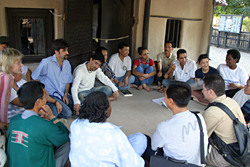
Future Generations teaches and enables a process for equitable community change that integrates environmental conservation with development. -- Mission Statement Excerpt
Criterion One: Mission and Integrity
Read
Chapter 2

Integrity pervades
every aspect of the management and operations of Future Generations. It
is about being what you say you are and doing what you say you will do.
It is about being a trustworthy partner in societal development and a
responsible steward for “generations yet to come,” as the conclusion of
our Mission Statement stipulates.
| Core Component |
Evidence |
|---|---|
| 1a: The organization's mission
documents
are clear and articulate publicly the organization's commitments. |
|
| 1b.
In its mission documents, the
organization recognizes the diversity of its learners, other
constituencies, and the greater society it serves. |
|
| 1c.
Understanding of and support for the
mission pervade the organization. |
|
| 1d. The organization's governance
and administrative
structures promote effective leadership and support collaborative
processes that enable the organization to fulfill its mission.
|
|
| 1e. The organization upholds and
protects its integrity. |
Criterion Two: Preparing for the Future
Read
Chapter 3

The organization’s allocation of resources and its processes for evaluation
and planning demonstrate its capacity to fulfill its mission, improve
the quality of its education, and respond to future challenges and
opportunities.
 Exhibit 3.1: December 2001 Board Meeting Word document
Exhibit 3.1: December 2001 Board Meeting Word document Exhibit 3.2: Strategic Planning Session August 2003 PDF document
Exhibit 3.2: Strategic Planning Session August 2003 PDF document Exhibit 3.3: Org Alignment & Plan of Action 05-15 and Plan for Growth 06-15 PDF document
Exhibit 3.3: Org Alignment & Plan of Action 05-15 and Plan for Growth 06-15 PDF document Exhibit 3.4: Strategic Plan PDF document
Exhibit 3.4: Strategic Plan PDF document Exhibit 3.5: Graduate School and CSO Budget Separation PDF document
Exhibit 3.5: Graduate School and CSO Budget Separation PDF document Exhibit 3.6: Attrition Rates PDF document
Exhibit 3.6: Attrition Rates PDF document Exhibit 3.7: Country Workplans PDF document
Exhibit 3.7: Country Workplans PDF document
| Core Component |
Evidence |
|---|---|
| 2a: The organization realistically prepares for a future
shaped by multiple societal and economic trends. |
|
| 2b:
The organization's resource base supports its educational programs and
its plans for maintaining and strengthening their quality in the future. |
|
| 2c: The organization's ongoing
evaluation and assessment processes
provide reliable evidence of institutional effectiveness that clearly
informs strategies for continuous improvement. |
|
| 2d: All levels of planning align
with the organization's mission, thereby enhancing its capacity to
fulfill that mission. |
Criterion Three: Student Learning and Effective Teaching
Read
Chapter 4
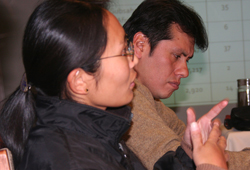
Through the three components of blended learning, applied field-based instruction
is combined with a multi-disciplinary curriculum spanning health,
conservation, and social science. Blended learning is a powerful,
flexible instructional tool, providing the pedagogical foundation of
each course.
 Exhibit 4.1: Minutes from Peru Residential Discussion Word document
Exhibit 4.1: Minutes from Peru Residential Discussion Word document Exhibit 4.2: Learning Outcomes/Syllabi PDF document
Exhibit 4.2: Learning Outcomes/Syllabi PDF document Exhibit 4.3: Faculty College Minutes Word document
Exhibit 4.3: Faculty College Minutes Word document Exhibit 4.4: Evaluation Form/Summary of Student Evaluations PDF document
Exhibit 4.4: Evaluation Form/Summary of Student Evaluations PDF document Exhibit 4.5: Moodle Discussion PDF document
Exhibit 4.5: Moodle Discussion PDF document Exhibit 4.6: Blended Learning from Catalog PDF document
Exhibit 4.6: Blended Learning from Catalog PDF document Exhibit 4.7: Practicum Syllabus, Template and Grading Rubric PDF document
Exhibit 4.7: Practicum Syllabus, Template and Grading Rubric PDF document Exhibit 4.8: Practicum Projects Word document
Exhibit 4.8: Practicum Projects Word document
| Core Component |
Evidence |
|---|---|
| 3a:
The organization's goals for student learning outcomes are clearly
stated for each educational program and make effective assessment
possible. |
|
| 3b: The organization values and
supports effective teaching. |
|
| 3c: The organization creates
effective learning environments. |
|
| 3d: The organization's learning
resources support student learning and effective teaching.
|
Criterion Four: Acquisition, Discovery and Application of Knowledge
Read
Chapter 5
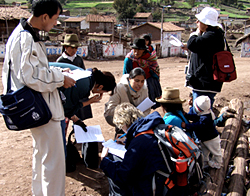
The ongoing acquisition of knowledge and its application are central to our mission, which recognizes the simultaneous and interconnected involvement of teaching, application, and basic research roles in higher education.
 Exhibit 5.1: Barbie Keiser Cybrary Training Powerpoint presentation
Exhibit 5.1: Barbie Keiser Cybrary Training Powerpoint presentation Exhibit 5.2: Cybrary Training PDF document
Exhibit 5.2: Cybrary Training PDF document
Criterion Five: Engagement and Service
Read
Chapter 6
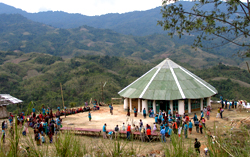
Serving a broad, globally inclusive constituency is a defining trait of the
graduate program of Future Generations.
 Exhibit 6.1: Depth For the Best PDF document
Exhibit 6.1: Depth For the Best PDF document Exhibit 6.2: Organizational Alignment and Organizational Plan 2005-2015 Word document
Exhibit 6.2: Organizational Alignment and Organizational Plan 2005-2015 Word document Exhibit 6.3: List of Partner Organizations PDF document
Exhibit 6.3: List of Partner Organizations PDF document
Federal Compliance
Read
Chapter 7
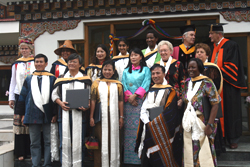
Future Generations Graduate School is in compliance
with all federal
requirements. The school recognizes that compliance with stated
requirements is essential to its integrity and that the implementation
of policies and procedures is necessary to maintain its reliability.
 Glossary
of terms
Glossary
of terms  Full
document, suitable for printing
Full
document, suitable for printing